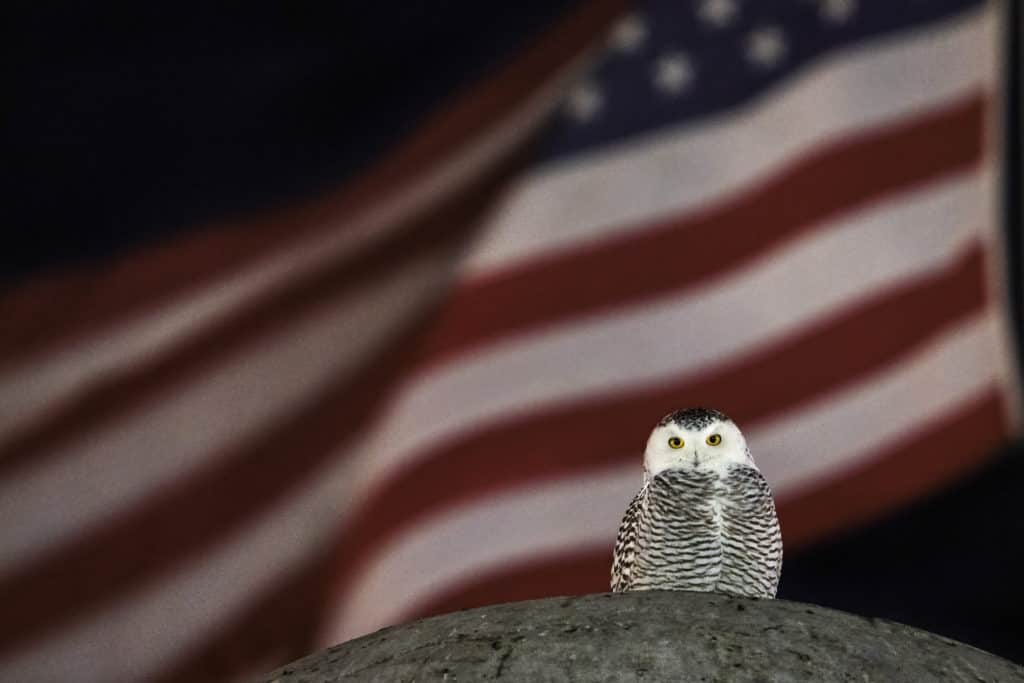Creature Feature

A Snowy in DC
By Wayne Bierbaum
Jan. 11 was cold and windy. Friends of mine, Barb and Tom Statas, drove into Washington, D.C., and by 5pm started to set up camera equipment just outside Union Station. Some 50 other people with binoculars, scopes and cameras joined them near the Columbus Fountain and they waited in the cold and dark. As the night went on, the crowd thinned out but finally at about 7:30pm the bright white under-wing of a large bird flashed in the streetlights. The bird landed on the globe top of the fountain and the cameras started clicking.
After calmly surveying the scene and preening, the large bird flew down and appeared to go after some prey and returned to the statue. Eventually, it caught a rat and flew off. Both Barb and Tom got some nice photos and returned two days later for even more stories and photos.
The bird was the now-famous DC snowy owl. It has been seen around Union Station since at least Jan. 3. It has been written about in multiple newspapers and featured in in-depth stories on ABC-7 News, CBS, and FOX. A French news service even wrote about it and the UPI published a photo of the owl sitting on top of Columbus’ head eating a rat.
I spoke to Barb Statas about her experience with the owl. She believes that it comes to Union Station mainly for getting food and the globe on top of the fountain makes a great perch. The bird did not seem disturbed by the onlookers. It was given enough space at the fountain and that it appeared calm and if it was anxious, it certainly could leave.
A bird expert told Barb that the owl was a young female, without a visible tag. She has been seen chasing pigeons and rats and was observed on multiple occasions eating a rat. The Union Station area has several homeless encampments nearby that attract many rats.
Snowy owls occasionally fly down from the Arctic Circle in the winter. Most of the birds that make the trip are juveniles. Years ago the cause of the winter migration was thought to be due to a lack of food. But it is now thought that the cause of the migration is due to very successful breeding and the young birds spread out to find more hunting grounds.
In winter of 2013-14, an irruption of snowy owls occurred and hundreds of snowy owls flew south. One was even seen as far south as the Bahamas. During that winter many of the birds were tagged and their travels were closely monitored in what became Project SNOWStorm.
It turns out that the owls feed mostly on lemmings in the summer and do not travel far. But in the winter, they are largely duck hunters and travel long distances to find open areas in the ice shelf where ducks congregate. When the owls fly south, they frequently end up along the coastal sand banks. At night, they hunt sea ducks and during the day, rest in the pale sand dunes that look similar to the arctic tundra.
Adult male snowy owls are almost pure white and females and juveniles have dark bars on their chest. Telling the difference between a juvenile and a female is difficult but the males start shedding bars until reaching adulthood at 3 years.
This year there seems to be more snowies than usual. However, because pressure from human contact disturbs their rest, most of the birding public has stopped reporting exact locations.
A snowy owl was seen along the South River this year but the photo and location were quickly removed. That makes the DC owl extra special because it will show up if it wants to and it rests in an unknown location.
Out of concern for the bird, the public has been asked to remove all forms of rat poison from the area around Union Station. Visitors are requested to be quiet and give the bird space.
